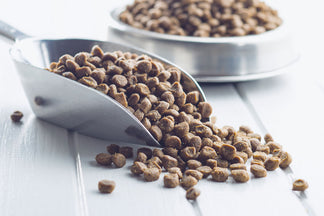For all animal-obsessed pet parents, nothing’s more important than the health and well-being of our furry children. We bring them to the vet for checkups, we drag them up huge hills for exercise (commonly known as “hikes”), and we comb them, kiss them, and cuddle them.
When it comes to food, we want the best - the best brands, the healthiest kinds of proteins, and the best combo of wet versus dry. But even the most well-intentioned puppy papas and meow moms may not know a few key pieces in the pet food puzzle.
1) Something’s Afoul Here: Our Pets Get Too Much…Fowl
Ever hear someone say “Tastes like chicken?” Well, if your fur baby ever uttered those words (what, your pet can’t talk?) listen up because he’s correct. Here’s why: chicken’s lurking around in 68% of all dog foods and 73% of all cat foods. If that doesn’t make you cluck your tongue, this should - chicken can be present in your pet food even if the recipe name indicates otherwise. (So don’t assume that kitty’s beefy-looking breakfast is fowl-free!) And because chicken is prevalent in the majority of our pets’ mealtimes, it’s frequently linked to food sensitivities, intolerances, or allergies.
2) Low-Carb: Not Just For Humans During Bathing Suit Season
When you wanna feel trim, you know you gotta say “no” to the bread basket during dinner. And obviously you wouldn’t let your kitty Buttons munch on a loaf of sourdough, but guess what? The average pet food contains too many carbohydrates and not enough protein. Seriously - typical dog food is composed of 41% carbs (yikes!) and cat food 31% (hiss!), and considering that dogs evolved from meat-loving carnivorous ancestors of yester-millennium and cats are obligate carnivores, that ratio is way too high. So you and Buttons can both be proud members of the Eat More Meat Club.
3) Grain-Free Is Not The Same As Low-Carb
What gluten-free has done to human diets, grain-free has done to pet diets = a front row seat on the trendy train, but most of us can’t explain the science behind the buzz. Many people associate grains with carbs, and therefore conclude that grain-free = low-carb, which is pawsitively not true. Grains are not the enemy, nor are they inherently bad. Some high quality grains can provide tremendous health benefits, so don’t fear getting “in-grained.”
4) Be Suspicious Of “Natural Flavor”
The word “natural” lost its credibility the moment it hopped onto the ingredients list for fast-food french fries. (No joke, there’s a “natural” form of sugar inside those potato-esque-abominations.) You should be wary of foods that boast about their “N-gredients,” and yes, that includes pet nosh. “Natural flavor” is an additive in many animal foods which could potentially sound healthy, but it’s hard to know exactly what this ingredient really is. Often the flavor is extracted using a chemical process with unnamed ingredients, like “digests.” A dog or cat food containing ample amounts of meats and fish that you recognize (like beef and salmon) should satisfy your baby’s palate without the extra mysterious flavorings. Much like you want your fries to contain just potatoes, oil, and salt, you want your pet food to contain clear, discernible ingredients.
5) Is Meat Listed As The 1st Ingredient? That Doesn’t Automatically Indicate Good Quality
It’s no secret that ingredients on a food label are listed in the same order as their relative weight in the recipe. So if meat appears as the frontrunner, your food is probably nutritious and good quality, right? Not necessarily. Know how Buttons likes to be sneaky and hide your water bottle caps all over the house? Food companies can also be sneaky by craftily manipulating the ingredients to push the meat component higher (and filler component lower) on the list. But how do they get away with that? There’s a tactic called ingredient splitting, and it’s sadly common. By breaking apart low quality ingredients into 2 or more components, like ground rice and rice bran, each rice ingredient individually accounts for a smaller portion of the recipe, and therefore pops up lower on the ingredient list - allowing meat to be at the forefront. This takes place in about 1/3 of all pet foods, so make a mental note next time you’re stocking up on meals for Buttons.
Here at Petnet, our goal is to help you make the best choices for your kiddies kitties and puppies. Equipped with an extra bit of food 411, you can sniff out the best ways to keep Buttons playing stealthy and living healthy.
Got any questions about your pet food? Drop us a line in the comments below.

 Food
Food
 Food
Food
 Food
Food
